
Chinese opera is one of the world’s oldest continuously performed theatrical forms, today comprising about 30 different styles and a repertory of thousands of operas having their origins in the Later Lao dynasty of the fourth century C.E.
On Aug. 30, San Jose-based Chinese Performing Arts Association brought a full afternoon of breathtakingly beautiful Beijing opera – one of the four predominant Chinese opera styles, and designated as the People’s Republic of China’s national art – to Santa Clara’s Mission City Center for Performing Arts at Wilcox High School.
Singers and instrumentalists from the Bay Area, Los Angeles, New York City and Taiwan performed famous segments of classic Chinese operas, including “Pearl of the Sea,” “The Broken Bridge” and “The Three Judges;” giving polished performances delighting audience eyes and ears.
Even those brand new to this performance art would find these storiesand their mix of comedy and tragedy very familiar: betrayal forgiven and estranged couples reconciled, a judge brought face to face with his own hypocrisy by a clever woman, and alluring treasure that makes someone stray from duty and become blind to danger.
Chinese opera is characterized by its dazzling costumes, highly stylized make-up;complex repertory of facial expression, hand gesture and movement; and, like Western opera, a distinctive vocal style designed to project and display the singer’s virtuosity. Because there are no props, the actors’ words and movements must tell the story, and dance, gymnastics and martial arts also play important roles in Chinese opera.
To Western ears, Chinese opera’s vocal style can initially feel very unfamiliar – unpleasantly so if the introduction comes from tinny YouTube videos. But heard live, the listener is rewarded by ethereal high notes, richovertones created by extensive use of vibrato, and a broad and expressive vocal”vocabulary” that tells a story and needs no translation.
The conventions of Chinese opera are in many ways the opposite of those of Western opera.
While in Western opera costuming and stage action are changeable elements of the production, the music and libretto are followed almost always exactly as written, and singers are expected to follow the orchestra conductor.
In Chinese opera, costumes and stage movements are the unchanging elements because they identify characters and communicate important elements of the story – which are based on myths and folklore well known to Chinese audiences. It’s music that’s the changeable element in Chinese opera. There can be many versions of an opera, identified with a particular singer, director or company rather than a composer.
High vocal registers are considered the most beautiful,so performers pitch the vocal parts – which, like Western opera, include speech, sung narrative (recitative), and songs (arias) – at the very top of their range, and men frequently sing in falsetto. Because the costume and makeup identifies a character, men can perform female roles and visa versa.One of Beijing opera’s most famous singers, Mei Lanfang (1894 -1961) was renowned for his performance of female roles.
Different performers in the same showcan sing in different keys, requiring the accompanying instrumentalists to retune their instruments. And the orchestra follows the singer, not the other way around.
Chinese opera uses the same 12 pitches used in Western music, and compositions are based on scales similar to the medieval church “modes,” from which modern Westernmajor and minor scales developed.
Aileen Wong of Saratoga, who sang several roles in the August 30 performance, started studying Chinese opera when she was 20, but didn’t pursue it at that time because she had started a dance school. Years later she returned to opera, this time dedicating herself to mastering the art. That skill was amply demonstrated in last month’s performance with Wong’s effortless sound and exquisite floating high notes that seemed to go on forever.
“It is very traditional and I fell in love with it,” she says.
To find out about other performances of Chinese opera in the Bay area, here are some organizations to check: the Chinese Performing Arts Association of San Jose (www.chineseperformingarts.org) and the Cantonese Opera Association of Silicon Valley (www.coasv.com).





